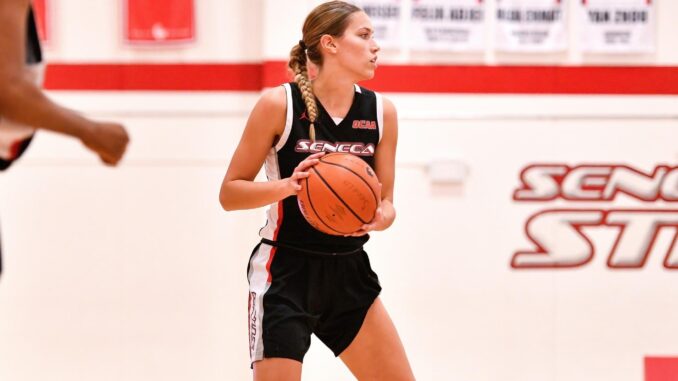
By: Nikki Partey, Suria Mujadidi, Naomi Proulx
There’s a certain excitement that can only be felt while playing and watching basketball. The thrill–or tension of watching your favourite athlete or team go against their rivals, breaking and setting their own or others’ records. Entertainment and numbers don’t seem like they should go together, but they certainly do. From following the progress of players to collecting data for bets, keeping track of athletes’ statistics and records is an integral part of the culture around sports.
A Sting Star

Hannah DeVries is co-captain and plays power forward. She is in her second year playing basketball for the Seneca women’s varsity basketball team. She was asked as an athlete how often she checks her stats and how her coaches and sports scientists use data to their advantage.
Hannah says that she and her coaches use data to track her performance and look for areas of improvement. They look at her shooting percentage, rebound count, and turnover rates to see where she is excelling and where she needs to focus more efficiently and effectively in this position. She is using the results of each game to measure her progress and determine how she can improve her skills and performance.
By reviewing her performance after each game, she is able to make the adjustments necessary to reach her priorities. Additionally, coaches and sports analysts use the stats to predict whether the team will win certain games. They also use statistics to compare both groups and look at each player’s stats to see if they have a high point total per game average.
This helps them to determine their team’s strengths and weaknesses and those of their opponents. They are able to use this information to craft strategies and plans that will give their team the best chance of winning. She added that when their group loses a game and their stats aren’t so favourable, they work harder and put in extra effort at practice the next day. This is to improve their stats.
Aside from being an athlete, DeVries desires to work as a nurse, and she is currently in the Seneca-York BScN nursing program. She is aware that her dedication and commitment to her team and studies will help her maintain an excellent grade point average, as well as help her build strong relationships with her Sport team and educators. She also knows that these qualities will give her the necessary skills and experience to help her excel in her nursing career.
We learned more about DeVries' goals on and off court in our interview, below.
Coaching By The Numbers
Kwame Obeng, assistant coach for Seneca’s Womens’ Varsity basketball team uses statistics to improve and guide the players' in their game. In coaching, stats are used to to track not only the team, but the opponents and their team as well. Obeng and his fellow coaches take notes on everything. From what their players' statistics looked like while they were in high school if they have any, to what their opponents' scores were in their last game. "Statistics [are] a good way to see where you are...you wanna be efficient in what you do,"
"The talent level has gone dramatically up, compared to before," remarked Obeng, when discussing the reasons why NBA players in the 70s were often over seven-feet tall, as compared to now, where most players are within the six-foot range.
Obeng has plenty of experience in basketball, not only as a coach, but also as a player, referee and fan. He has seen how basketball has evolved to become more technical, and the statistics prove it: "For example, shooting wise. You want to be shooting at 50%, as opposed to back in the day were players were shooting maybe in the 30s, 40s. Shooting at 50% is more common now...if you want to elevate your team and make it better, every percentage counts."
Lebron’s New Legacy
Lebron James is in good company at the top of the list of the NBA's top five scoring players.
The competitive nature of basketball makes statistics tracking even more critical, both as teams and individual players. A team with a great record for championships will be more attractive for trade decisions players make. One of the most iconic instances of this, was NBA Decision 2010 when Lebron James announced he would take his “talents to South Beach”, leaving his home team the Cleveland Cavaliers.
13 years and four championships after “The Decision”, James was set to start a new scoring legend.
On April 5th of 1984, Kareem Abdul-Jabbar set an all-time scoring record of 38, 387 that wouldn’t be surpassed for 38 years, until Lebron James scored his 38, 388th point with 10.9 seconds of the third quarter against the Oklahoma City Thunder on February 7th of this year.
NBA fans, past and present players were watching in anticipation to see what was considered to be an impossible record, surpassed. In an interview with Marc Stein in September of 2021, when asked his thoughts on James gaining on his record, Abdul-Jabbar said the following,
“I’m excited to see it happen. I don’t see records as personal accomplishments, but more as human achievements. If one person can do something that’s never been done, that means we all have a shot at doing it,”
These sentiments embody the spirit of how statistics enrich the sport they are tracked in. There are, of course former players who aren’t quite as encouraging or pragmatic in their response to their once unparalleled records being crushed.
In the games leading up to James’ record breaker, it seemed like the world was keeping track of his points per game.
Basketball is an incredible sport that has grown and changed rapidly over the last hundred years. Fans, players and everyone in between have been able to appreciate, follow and participate in the sport through improvements to technology, and of course, statistics.


Be the first to comment